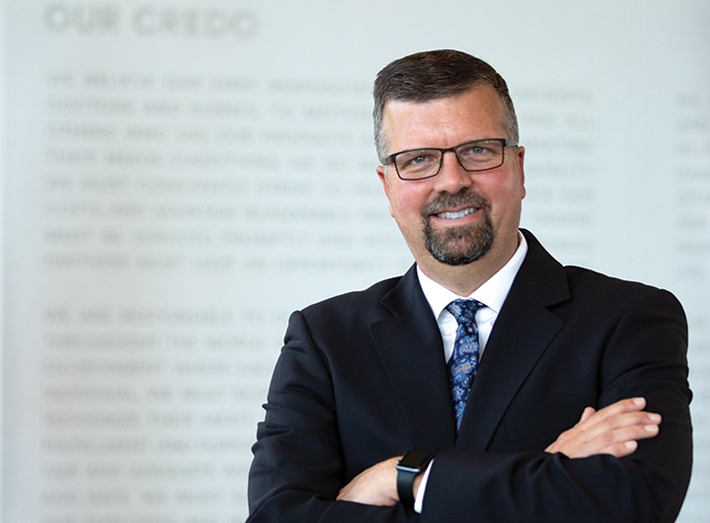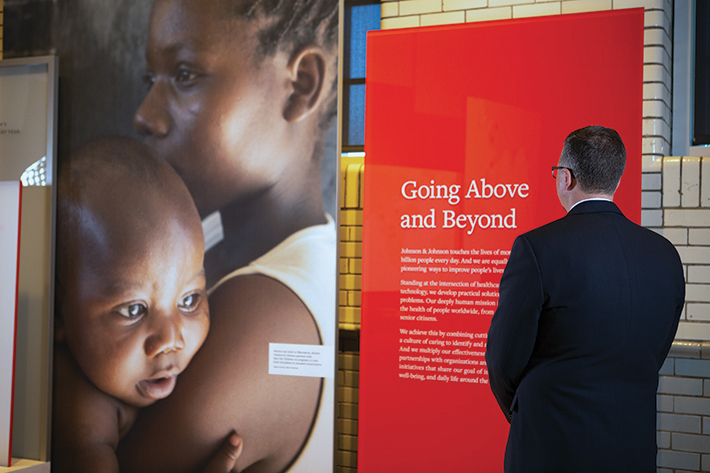
Q&A with John Logar
John Logar has done many things in his life deliberately. He has served on local school boards, coached youth sports, and graduated with a degree in mathematics from Rowan University in New Jersey. However, when it comes to his career path, which has led him to the position of senior director of aseptic processing and terminal sterilization with Johnson and Johnson — as well as to his role as the 2021 ASTM International board chair — that was different.
“I got involved with radiation processing by accident,” he says. “I graduated with a degree in mathematics and didn’t know what I wanted to do. So I pulled open the newspaper, found an opportunity, and joined a sterilization contract facility using gamma radiation.”
Things seemed to fall into place from there, as Logar soon discovered a passion for the science of radiation processing. And with the help of some early mentoring, he was able to advance his career, eventually working with some of the biggest names in the field.
READ MORE: A Partnership to Help Prevent Infection
Along the way, he made another discovery when he was asked by a colleague to join ASTM International in 2001. The experience changed his life and his career trajectory, as he credits his work with the subcommittee on food irradiation (now E61.05) with propelling his career at Johnson and Johnson to its current heights.
Today, Logar is a past chair of the committee on radiation processing (E61) as well as its subcommittee on dosimetry (E61.01). Previously he served as the chair of the subcommittee on radiation dosimetry (E10.01) in the nuclear technology and applications committee (E10), where he led the expansion of the subcommittee and the transition to the independent committee it is today (E61). He received the Peter D. Hedgecock Award in 2010, which recognizes outstanding personal performance in service to the nuclear technology committee or one of its technical subcommittees. Logar, who also served on the ASTM Committee on Technical Committee Operations from 2012 to 2014, is also a member of the committees on quality and statistics (E11), primary barrier packaging (F02), manufacture of pharmaceutical and biopharmaceutical products (E55), and medical and surgical materials and devices (F04).
Q. What is microbiological quality and sterility assurance (MQSA) and how is it supporting Johnson and Johnson’s efforts to develop a vaccine for the COVID-19 virus?
A. Critical microbiological quality and sterility assurance activities take place throughout our entire supply chain and are embedded in the design, manufacturing, and delivery of our products.
For example, a product must be designed correctly in order to be sterilized effectively. And it must have a container closure system that ensures it maintains the product sterility at the time of use. This includes every step of the manufacturing process, throughout the sterilization process, delivery, and storage. These are some of the critical activities in ensuring our patients receive sterile end products.
With regard to the manufacturing of a vaccine, when we manufacture any product, our teams get directly involved to ensure that the environments where we’re going to manufacture the product are of the highest microbiological quality. We’re trying to prevent contamination. When we talk about introducing components that are intended to contain the product or the vaccine for distribution to customers, we have to make sure the containers are sterile. And so we work directly with the manufacturing teams and R&D teams to ensure that the methods used for manufacture of the product deliver a microbiologically safe and effective product.
Q. How did you first become involved in the field of radiation processing and how did that lead to your current role with Johnson and Johnson?
A. I got involved with radiation processing by happenstance. Coming out of college, I didn’t really have a clear vision of what I wanted to do so I went to work for a temporary employment agency in a quality-control role. That experience led to a role as a quality manager for a contract irradiation company.
While in that job, I immersed myself in the science of radiation processing, and by connecting with several of my career mentors, I was able to learn and grow within the field. Through that growth, I was able to engage with ASTM, and after several years in the industry, I had the opportunity to join Ethicon, a Johnson and Johnson company. In that role, I was able to expand my experience from radiation processing to other terminal sterilization modalities. And after a short stint there, I was able to join the corporate sterility assurance team at Johnson and Johnson under the leadership of Joyce Hansen, a sterilization pioneer in the healthcare industry. Together, we were able to craft a strategy to make microbiological quality and sterility assurance a true technical competency.

Q. You’ve also been with ASTM International for 20 years. How has your involvement with ASTM impacted you personally and helped you grow professionally?
A. ASTM has helped me grow significantly from a technical and management standpoint, which has enhanced my career development. It’s the reason I’m with Johnson and Johnson today. Going through the interview process with Ethicon, I remember asking the hiring manager: Why me? I’m an individual contributor with one technical competency. Why do you think I can lead a group for your team? Her answer is something I’ll never forget. She said the leadership you demonstrated at ASTM managing a committee is something that we believe can translate to Johnson and Johnson and why we think you can be a great leader for us.
On a personal level, this field has allowed me to use and develop my technical skills while working to benefit the patients that use the products. This field is mostly driven by on-the-job learning, and forums like ASTM provide an environment where you can learn from others, build your network, gain experience. But even more, it’s the intangibles that working in an ASTM committee brings: influencing without authority, learning how to collaborate, leadership skills, negotiation. These are all things that are critical to leaders in companies like Johnson and Johnson, with over 125,000 employees. These are skill sets that are paramount to being an effective leader, and I got to develop them in my roles through ASTM. I was able to learn by working with experts from around the world, trying to reach 100% consensus, making sure that everyone’s voice is heard. That’s a skill set I bring to the office every day.
FOR YOU: Manufacturing Safe Vaccines
At ASTM, you are the member, and your membership is not tied directly to the company you work for. Thus, if you happen to leave your job, the leadership roles, the roles within your committee, all continue and become a lever that you can use with your next organization. It becomes value added to you. When you talk about the extra hours you put in working at ASTM, you need to make sure that the time and effort is beneficial to your company and that you’re taking advantage of all the opportunities it’s giving you as well. Whether it’s leading a subcommittee or working on a standard, that’s changing the way science is delivered. These are experiences that can build value, and you take that experience wherever you go.
Q. ASTM International is rolling out its ASTM 2.0 website in the coming months. How will this impact and benefit members of ASTM and users of ASTM.org?
A. ASTM 2.0 is going to set the foundation for years to come. A lot of what’s being done will enable tremendous growth, speed, and agility. The ASTM 2.0 rollout modernizes the architecture of the ASTM technology platform for the whole organization.
The new platform will support the standards development process, enhance tools for members and the delivery of products and services for customers, and provide more functionalities in our SpecBuilder collaboration tool and website. A lot of the improvements in the initial rollout of the ASTM 2.0 platform are in the background and will be transparent to the end user. However, this foundation provides the needed infrastructure to support both current and future services and applications, to position ASTM for future innovation. ASTM 2.0 is all about digital transformation and the digital next generation.
Q. Diversity and inclusion has become a major organizational priority for ASTM. How is the board helping to improve and expand ASTM’s diversity?
A. Diversity and inclusion (D&I) has always been a big part of ASTM’s success over its 120+ years. ASTM has always been an open organization, and it relies heavily on inclusion and diversity of thought to drive standards development as well as its organization.
That being said, there’s always room for improvement. ASTM’s purpose is to ensure it continues to represent its employees and global membership adequately. So that every voice is heard and because every voice matters, last year, ASTM president Kathie Morgan led a cross-divisional team of 24 staff in developing a series of recommendations regarding a more formal program for diversity and inclusion.
The board was pleased to approve an organizational commitment statement to D&I at a recent board meeting. One of the recommendations was the formation of a D&I council as part of this effort. One ASTM board officer will serve on this council to provide governance support, but this also enables the board to contribute to the overall organizational strategy, as well as to embed the strategy into the nominating committee processes.
Watch the 2021 Chair Video:
Q. Where do you see ASTM International moving in the future, and how are you planning to help shape that future as chair?
A. 2020 has been a very challenging year for all of us. In 2021, ASTM has several initiatives focusing on enhancing the value to its members, its organizations, and the industries it represents. It has never been more critical to take care of the members who support ASTM. They’re focused on virtual meetings, virtual engagements, and figuring out how they can continue their collaborative work in the environment we’re in today. ASTM 2.0 is the start, but there’s plenty of opportunity and innovation ahead.
Starting in 2021, as chair, I hope I can take my personal journey and the experience of how ASTM has benefited me throughout my career and translate and integrate this into the strategic initiatives that the organization has set forth. To demonstrate how we together can enhance the value that members see in their participation, not only for themselves, but for their organizations
and industries.
 SN Home
SN Home Archive
Archive Advertisers
Advertisers Masthead
Masthead RateCard
RateCard Subscribe
Subscribe Email Editor
Email Editor